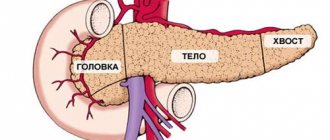There are contraindications. Specialist consultation is required.
Symptoms of neoplasms in the gastrointestinal tract Methods of treatment of gastrointestinal tumors Diagnosis and treatment of neoplasms of the esophagus Prevention
Neoplasms of the stomach and intestines include various tumors (polyps, lipomas, lymphomas, fibromas, hemangiomas, etc.) that can arise in the gastrointestinal tract. Benign tumors are characterized by slow growth and a favorable prognosis, but these formations can become malignant and pose a serious threat to humans.
Causes
As a rule, the cause of papillomatosis is a virus. It is caused by the human papillomavirus (HPV), which has almost a hundred different types, some of which have cancer potential.
HPV is transmitted through contact, including sexual contact. HPV can be transmitted from mother to child during pregnancy or childbirth.
Usually there are no symptoms of the presence of the virus, but they appear in the form of papillomas if a person’s immunity decreases.
Another cause of the disease is chronic inflammatory processes.
In some cases, the appearance of the disease is not caused by anything at all.
Reasons for the formation of papillomas in the mouth and possible locations of their localization
The appearance of all types of papillomas is associated with infection of the patient with the human papillomavirus (HPV). The prevalence of this type of viral agent is very high and reaches 90% of the population in some countries. However, HPV carriage is not always accompanied by the formation of skin tumors. The virus can remain latent for a long time without manifesting itself at all. The formation of papillomas is promoted by factors such as decreased immunity, bad habits, poor nutrition and hormonal imbalance.
Science knows more than 100 types of human papillomavirus. The location of the tumor directly depends on the type of HPV. Papillomas in the mouth, covering the surface of the mucous membrane, are caused by HPV types 13 and 32, affecting various parts of the oral cavity:
- Papillomas on the tongue. The tongue most often undergoes epithelial hyperplasia, which is usually manifested by the formation of fine granularity or single tubercles of the mucous membrane of the tongue. In the first case, multiple small growths are felt as an unpleasant surface roughness, while the second type of neoplasm, being quite large, is often injured and causes its owner not only discomfort, but also pain.
Papillomas on the tongue usually appear in the tip or lateral parts of the organ. Papilloma under the tongue can also be considered a frequent occurrence. The root of the organ is least likely to suffer from such growths. The color characteristics of papilloma vary from light pink to bright red.
- Papilloma in the throat. Papillomas in the throat can remain undiagnosed for a long time, since they usually do not cause significant pain in the patient. Owners of such neoplasms of the mucous membrane note minor discomfort and sore throat, which is not given any importance.
If the papilloma increases in size, it can interfere with normal food intake and even change the voice of its owner, making it more muffled. The growth itself usually looks like a soft whitish or one-time bump with a rough surface. Papillomas on the tonsil are especially common.
- Laryngeal papilloma. One of the most unpleasant types of localization of neoplasms. The fact is that the formation of laryngeal papillomas interferes with the breathing process, which can lead to acute hypoxia. This phenomenon is especially typical for young children who cannot clearly formulate complaints about difficulty breathing.
- Papilloma on the lip. Such epidermal growth usually causes more trouble from an aesthetic point of view than from a physiological point of view. However, excessive growth of the tumor increases the risk of injury during eating or active facial expressions.
- Papilloma on the gum. Usually characterized by the absence of symptoms and any pain. If a papilloma on the gum has formed in a place that is invisible to the patient. It can only be detected by visiting a dentist.
Disease in the larynx
Statistics show that this variant occurs in 2 people out of 100,000 adults and 4 children out of 100,000 people.
Symptoms that characterize this option:
- Hoarseness;
- Breathing disorders.
The development of the disease can lead to:
- Laryngeal stenosis;
- Penetration of papillomas into the trachea and bronchi;
- Development of pulmonary failure;
- Degeneration into a malignant tumor.
Vestibular disease
Edema in cancer
It affects women under 30 years of age. If a disease of this type is detected, it is necessary to examine the mucous membranes of the vagina and cervix.
This type, as a rule, develops without any symptoms; it can only be detected at an appointment with a gynecologist.
In some cases, the symptoms of the disease are:
- Beli;
- Pain;
- Burning in the vulva area;
- Dyspareunia;
- The process of inflammation.
Skin disease
This is the growth of many skin tumors in a local area. The usual size of skin papillomas is 5–7 millimeters, but neoplasms up to 2 centimeters can be found.
The shape of the neoplasm resembles dotted or slightly drooping skin growths or peas. Usually the color of the growth is exactly the same as the skin around it, but new growths of brown and white colors are observed.
Typical localization of neoplasms is the back, palms, fingers, soles, feet, eyelids, neck, axillary and inguinal areas.
The disease, as a rule, has no symptoms; its danger is that injured tumors can cause inflammation or turn into malignant tumors.
Stomach papillomas
02.06.2021
Gastric papillomas cause a disease called gastric and is characterized by the formation of benign growths on the mucous membranes of the digestive organs. Such growths do not appear on their own; most often they accompany gastric diseases such as gastritis , ulcers and others. Most often, gastric papillomas look like polyps on legs and are located in groups, but it happens that single ones are also found.
Types of gastric papillomas
Most often, two groups of papillomas are distinguished. These include:
- papillomas attached on stalks to the mucous membranes of the digestive organs, one at a time or in groups;
- papillomas that look like cerebral convolutions that accumulate in such a way as if they grow in one ridge.
There are also two more groups of papillomas:
- those that are located in a cluster, and those that grow alone;
- small and large;
- located on a wide base or on a thin stalk;
- those that have no symptoms and those that cause unpleasant consequences in the form of bleeding, exacerbation of chronic diseases, and the like.
The most common types of gastric and squamous cell papillomas of the stomach .
Symptoms of gastric papillomas
Most often, the appearance of gastric papillomas causes the following symptoms:
- pulling and aching pain in the so-called “stomach” area, moving to the lumbar region or the area of the shoulder blades (often occurring while eating);
- disruption of bowel movements;
- increased salivation;
- frequent gas formation in the stomach ;
- the appearance of bad breath ;
- unreasonable nausea and vomiting;
- the appearance of gastric bleeding.
If you have at least a few symptoms, you should definitely consult a gastroenterologist , because only he will be able to carry out the appropriate diagnosis and tell you how to treat papillomas in the stomach .
Dangers of gastric papillitis
Many people are negligent about their health, however, when faced with the disease “stomach papillitis”, they begin to wonder: are the stomach If you don’t treat them and let everything take its course, yes, because papillitis can develop into stomach cancer .
Treatment of gastric papillomas
In order to prescribe adequate treatment for gastric , the doctor must diagnose the disease. In this case, the following methods are used:
- X-ray of the digestive system;
- fibrogastroscopy;
- Ultrasound of the gastrointestinal tract.
Based on all analyzes and studies, treatment is prescribed. When papillomas are benign, compliance with therapeutic measures can lead to their complete destruction, but the fibrogastroscopy procedure will have to be performed once every six months.
If the polyps are medium in size, then a procedure is prescribed to remove - endoscopy . Most often, it does not have any consequences for the human body, but the patient must be observed for 10 to 14 days by the doctor who performed it. If the papillomas are large in size, then a more serious surgical intervention is required, after which the patient is recommended to adhere to a strict diet .
Published in Gastroentorology, Surgery Premium Clinic
Esophageal disease
The pathology is quite rare. The resulting neoplasms resemble polyps or leaf-shaped whitish formations in appearance. Their usual size does not exceed a centimeter. They are localized in the distal parts of the esophagus.
The main reason for the development of this form of the disease is human papillomavirus infection, however, papillomatosis can be observed in its absence.
As a rule, there are no symptoms for a long time, but as the disease develops, it is directly related to:
- Difficulty swallowing;
- Pain behind the sternum;
- Belching;
- Nausea.
This type of disease is considered precancerous, so if it is detected, surgical intervention is necessary.
Symptoms of neoplasms in the gastrointestinal tract
Typically, benign neoplasms of both the stomach and intestines do not reveal themselves in the early stages and are detected only during endoscopic examination. The patient may be occasionally bothered by some symptoms: nagging or aching pain after eating, belching, nausea, heartburn, bowel irregularities, bleeding during bowel movements. If you have these symptoms, you should consult a doctor to diagnose and remove tumors of the digestive tract.
Intraductal disease
In this case, neoplasms arise in the mammary gland, in its milk ducts. As a rule, the formations do not exceed a centimeter, but gigantic ones are also observed - more than five centimeters. The latter deform the mammary gland. Increasing in size, neoplasms contribute to mechanical expansion of the duct, which leads to pain.
Typically, this type of disease affects women between thirty-five and fifty-five years of age. The disease can be caused by:
- Taking oral contraceptives;
- Taking hormonal drugs;
- Family history;
- Endocrinological disorders;
- Chronic inflammatory processes of the appendages.
The symptomatic manifestation of the disease is an amber-colored discharge from the nipple or a discharge mixed with blood.
The patient may complain of discomfort and soreness. Upon palpation, a lump is detected in the mammary gland.
There is a high probability of the neoplasm degenerating into cancer, so if it is detected, surgical treatment is necessary.
Stomach polyps
The appearance of polyps is extremely varied even within one organ - the stomach.
Polyps are pedunculated and broad-based (stalked polyps and sessile), they are located alone, in nests, and can cover the entire gastric mucosa. Pedicled polyps are sometimes located at the top of the folds of the mucous membrane, being a continuation of them. The shape of polyps is often spherical or oval, less often - papillary or mushroom-shaped. Sometimes numerous soft individual villi are combined into a cluster-shaped mass. The cauliflower type has villous papillomas, which more often turn into cancer. The surface of linden trees is velvety, smooth, bumpy or granular. The color of the polyp depends on its structure, the amount of connective tissue, blood vessels, and the degree of malnutrition. Polyps are gray, red, purple-red, orange, pinkish-cherry. The color of the polyp may differ from the color of the surrounding gastric mucosa. The consistency of polyps depends on the histological structure. When fibrous tissue predominates, polyps are dense, while glandular tissue is soft.
The development of pathomorphological changes in gastric polyps can be conditionally presented in the following form: polypous gastritis, gastric polyps, stomach cancer.
The structure of single and multiple polyps is the same. The body of the polyp consists of glandular elements or of overgrown integumentary epithelium and connective tissue rich in vessels. The stalk of the polyp is a continuation of the adjacent mucous membrane and submucosal layer.
The glandular elements of benign polyps are similar to the surrounding tissue, the epithelium is slightly changed. In some places the glands are expanded into cystic cavities. The glands never extend beyond the muscular membrane, no matter how significant the glandular hyperplasia and hypertrophy is. The structure of polyps is similar to the structure of polypous growths in hypertrophic polypous gastritis.
Relatively benign polyps differ histologically from benign polyps by the appearance of pronounced atypia in the structure of glandular elements, the variety of shapes and sizes of glands, and the absence of highly differentiated glands. The submucosal layer in the area of the polyp is thickened. Malignant polyps are characterized by polymorphism of cells and nuclei, nuclear hyperchromatosis, a large number of mitoses, the formation of giant cells, and a violation of cellular complexity and polarity. Determining the histological criterion for the malignancy of a polyp can present some difficulties.
The advent of fiber endoscopes with a “biopsy channel” and the development of special auxiliary instruments currently allow polypectomy to be performed during gastroscopic examination. In this case, a morphological study of the structure of the entire polyp provides an opportunity to reliably determine the nature of the tumor.
The development of cancer is often preceded by various pathological processes. Precancerous diseases include ulcers, foci of hyperplasia - developing polyps, long-term chronic inflammatory changes in tissues with pronounced phenomena of proliferation and dystrophy and other diseases, timely diagnosis and elimination of which can in many cases prevent the development of cancer.
There are three variants of the combination of polyp and cancer. The first group - cancer from polyps, invisible to the naked eye, most often begins in the form of a small single node, which in appearance resembles a benign polyp. Up to 10% of all gastric carcinomas arise from polyps and papillomas, invisible to the naked eye. The second group is cancer from a polyp, visible to the naked eye. Such a polyp is first diagnosed endoscopically or radiologically and has some features: it goes through a long stage of changes until cancer arises from it. There are known cases of cancer developing from one villus of a polyp. Therefore, in case of gastric polyps, it is necessary to examine all polyps serially. After gastric resection, the development of polyps does not always stop. Polyps and cancer can develop on the remaining mucous membrane of the stomach stump.
The third group is polypous cancer, which is common (up to 8% of all cancers). Secondary stomach polyps can develop on a cancerous ulcer or along its edge. But these patients always have single or multiple polyps far from the tumor. Studying the structural changes of polyps during the process of malignancy, it was revealed that a number of sequential transformations of the epithelium are observed: normal epithelium - proliferating epithelium - carcinoma in situ - invasive cancer. Malignancy can develop not only in the polyp, but also in the surrounding mucosa, in which, as in the polyp itself, foci of multicentric proliferation and cancer in situ are found. All researchers consider polyposis a disease that represents a real basis for malignant transformation.
Thus:
1. Polyps and adenomas of the stomach are very “restless” formations, and we do not know when cancer can be caused by them, since polyps clinically give few signs; their symptoms mainly depend on the accompanying atrophic or hypertrophic gastritis. 2. Based on clinical observations, it seems that cancer from a polyp often occurs within 1–2 years. 3. Polyps that flow without clinical symptoms and are recognized by chance during gastroscopy, especially if the composition of gastric juice is normal, can exist for a longer time without developing carcinoma, but as soon as acidity begins to decrease, cancer may soon occur. 4. A polyp on a specimen, which outwardly appears benign, may turn out to be malignant upon microscopic examination (“malignization of the polyp”). 5. Even the smallest cancers, emanating only from the head of the polyp or from its stalk, can give early metastases. 6. To definitively determine the malignancy of a polyp after its resection, it is necessary to subject the specimen to serial examination, and all polyps must be examined.
Diagnostic measures
Often the disease is detected during the initial examination, because neoplasms have characteristic forms - a soft, dense tumor on a stalk, the size of which usually ranges from a centimeter to two. The tumor has an uneven outer surface, its color is white or brown. Sometimes the overgrown tumor looks like cauliflower.
The choice of instrumental diagnostic methods is influenced by the localization of the disease:
- Larynx – laryngoscopy;
- Esophagus – endoscopy;
- Mammary gland - ductography.
In order to confirm the viral origin of the neoplasm and determine its specific type, it is necessary to study using laboratory techniques - polymerase chain reaction, hybridization methods.
An assessment of the patient’s immune status is important in complex treatment; it is used both when prescribing drug therapy and for preventive measures.
Treatment
Surgery is the main treatment method for papillomatosis. At the same time, traditional excision can cause scarring of the mucosa. To avoid this, gentle intervention methods are used today:
- Removal using laser;
- Ultrasonic disintegration;
- Radiofrequency cold ablation;
- PDT;
- Electrical destruction;
- Cryodestruction;
- Diathermocoagulation and some others.
It is impossible to guarantee the absence of relapse with any of the listed methods. To minimize the risk of relapse after surgery, in some cases, adjuvant drug therapy is prescribed, including antiviral drugs and immunostimulants.
How are neoplasms of the gastrointestinal tract treated?
Stomach tumors are removed using an endoscope during esophagogastroduodenoscopy (EGD) - a diagnostic examination when the doctor identifies the condition of the inner surface of the stomach. Intestinal tumors are also removed using endoscopic equipment. An endoscope equipped with a loop electrode is inserted into the anus, which compresses the stalk of the tumor. Tumor tissue is submitted for histological examination to confirm its benignity. The endoscopic method of removing benign tumors is well tolerated by patients; after the operation, a person’s performance is restored the very next day.
Preventive actions
A vaccine has now been developed against several types of disease that can develop into cancer. It is intended for both children and adults.
When a disease is detected, dynamic monitoring of patients is necessary for treatment. Those suffering from laryngeal papillomatosis must be referred for medical examination. Its frequency is once every 3 months. For vestibular diseases, dynamic control is also necessary.
The Onco.Rehab integrative oncology clinic takes care of its patients, trying to prevent the development of precancerous pathology into oncology.











